Media / Editorial Reviews : Product Reviews
Ryobi P3410 Grease Gun 18V One+ Video Review
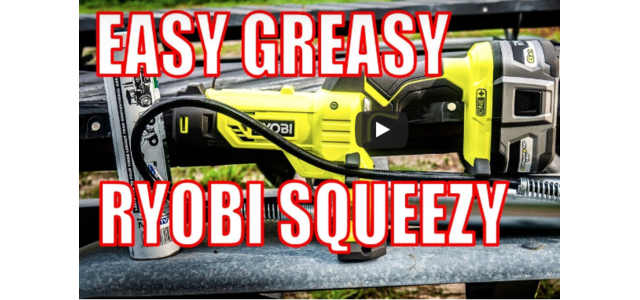
Using the Ryobi P3410 Grease Gun is very simple and it makes greasing much easier than using two hands to pump a manual grease gun. One charge on a battery will empty more than 15 grease cartridges. Bare tool price for the Ryobi grease gun is just $129.
Click here to read the full review.
Ryobi P3100 18V Hybrid Solder Station Video Review
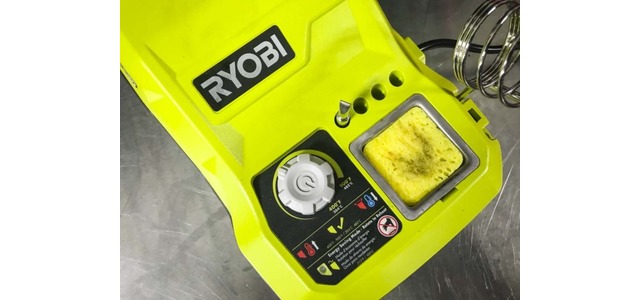
For some reason, splicing and repairing wires around the shop (in vehicles) has become a regular practice around here. The Ryobi P3100 18V hybrid solder station offers a freedom that others don’t. Just stick in an 18V battery, or plug in an extension cord. In less than a minute, the soldering iron is up to temperature.
Ryobi P3100 18V Hybrid Solder Station Features
400F to 900F Power Dial
You can easily select your desired temperature, from 400F to 900F, with the power dial. An LED light shines red while the Ryobi P3100 is heating up. Once to temperature, the LED shines a solid green. Power down the Ryobi 18V hybrid solder station and the LED blinks red until it’s cool. The actual soldering iron is attached to the base unit by a 3-foot cord. The Ryobi solder station base provides onboard tip storage, a tip-cleaning sponge, and iron holder for safe storage.
Extending runtime, the Ryobi P3100 will automatically shift into a lower heat mode, after 10 minutes of use. Just move the power dial to return to normal. After 20 minutes of use, the Ryobi 18V hybrid soldering station will turn itself off. Again, any movement of the power dial will return it to normal operation.
To watch the Full Video Review, Click Here.
Ryobi 18-Volt Hybrid Air Cannon Drum Fan Review
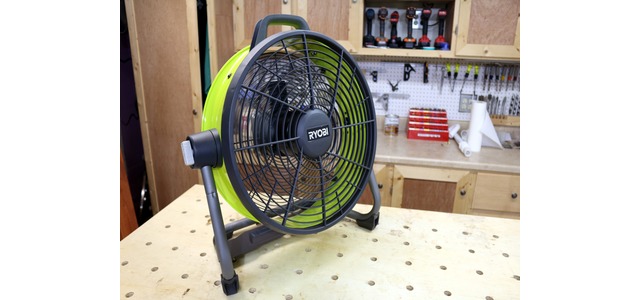
One of the things Ryobi has been doing that I particularly like is they have been releasing a lot of their 18 Volt tools in hybrid models. Their latest release is the Ryobi 18-Volt Hybrid Air Cannon Drum Fan.
In order for a tool from Ryobi to be labeled as a hybrid, it must be able to be operated by a battery or an electric cord. I love this concept. It allows the user to have the mobility of a battery tool and the long run time of a cord. Depending on the users need and/or access to an electrical source, they can choose how to power the tool.
About 4 years ago, all of the major tool brands started releasing small personal sized battery operated fans. Even though the fans looked very similar, there are differences that set them apart from each other. They differed by how loud they are, how much variable speed control they have and whether or not they are a hybrid model.
In case you are wondering, my absolute favorite small battery operated fan model is the Ridgid 18-Volt Hybrid Fan because it is the quietest, the variable speed control is completely adjustable and it is a hybrid model. It checks all of the boxes.
Ryobi seems to be leading the way and is first to market with a new and much larger size air mover which they have dubbed an “Air Cannon”.
Ryobi 18-Volt Hybrid Air Cannon Drum Fan Review Features
First and foremost, this drum fan is a hybrid where it can be run off of a Ryobi 18-Volt battery or off of an extension cord. These receptacles are found on the back of the fan.
The fan can be rotated 220 degrees and held into place by tightening the knobs on the sides.
The body of the fan and the back grill are made of metal.
The fan blades and front grill are made from plastic.
Three different levels of fan speed on controlled from the back of the unit.
A top mount plastic handle makes the unit easy to carry.
There is a screw mounting hole on the base. This gives you the ability to mount this fan to a wall if necessary.
There is a 4-foot cord included with the fan. This is particularly nice if the only extension cord you have does not fit in the fan receptacle. For instance, if you have an extension cord with multiple receptacles at the end, it won’t fit with this fan. The included 4-foot cord fixes that issue.
Ryobi 18-Volt Hybrid Air Cannon Drum Fan Review Performance
The airflow coming out of this fan is much greater than the smaller units that came out a few years ago. Ryobi claims this unit can make up to 2,400 CFM. With no way of proving or disproving this claim all I can say is that this unit sends out about the same air movement as a good box fan.
Even though the air flow is about the same, the noise from the Ryobi unit is noticeably quieter than a box fan. It is rated at 38 decibels and according to the meter on my phone, which was very close to what I was seeing. In case you don’t have a frame of reference for decibels, this is very quiet.
This unit is very light, easy to move around and very adjustable. It is nearly perfect in these regards. The only way this could be better is if it not only rotated up and down but side to side as well. This would allow it to pivot in any direction without ever having to be moved.
The hybrid option on this fan is just awesome. I love this. I’ve used the small Hybrid Ridgid fan in the past with a cord so that I could keep a continuous flow of air going over some of my projects in order to try the polyurethane finish evenly. I’ve also used that fan during camping trips with a battery on low to cool me off at night.
Ryobi 18-Volt Hybrid Air Cannon Drum Fan Review Value
The Home Depot has the Ryobi 18-Volt Hybrid Air Cannon Drum Fan listed at $139.00. This includes the fan, and 4-foot cord, but no battery.
Even though I think everyone who owns Ryobi batteries should own and would love this unit, I feel the $139.00 price tag is just a little steep and would be a much better buy at $99.00
Ryobi 18-Volt Hybrid Air Cannon Drum Fan Review Final Thoughts
A battery operated fan wasn’t really an item that I gave much attention to until I tried out a few of the small models released a few years ago. Since then, I’ve found them very useful and love that they are as mobile as they are. The one thing that wanted to see improved on was the amount of air flow produced.
It appears Ryobi has taken the battery operated fan to the next level and I am loving it.
To Read the Article in full, click here
New Huge Ryobi Cordless Fan
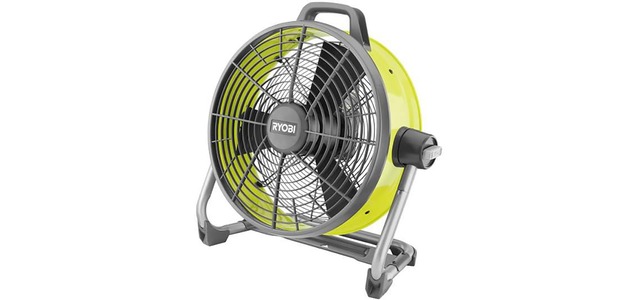
Moze sent over a heads-up about Ryobi’s new 18V 18″ cordless fan, called the “Air Cannon,” P3340.
Haven’t seen a bit of mention of these anywhere. Just came across them at my local Home Depot. Not sure how you release the largest, most powerful cordless fan on the market this quietly, but here it is.
They also sent over a photo of the new Ryobi cordless fan next to Dewalt’s, and the size difference is substantial.
The new Ryobi hybrid-powered Air Cannon drum fan features 220° head rotation range, and can provide up to 2400 CFM of airflow.
It can be powered by Ryobi 18V One+ Li-ion battery, and it also comes with an AC cord for plugging it into a wall outlet.
Ryobi says that it has “quiet air movement technology,” but doesn’t clarify about what this means. I’d guess that it means the fan speed is limited to prevent excessive noise. Larger fans can be slower than smaller ones and still move a lot more air.
The fan can be placed on the floor, and there is also a keyhole-style screw mounting hole in the base for securing it to a wall.
Additional features include a 3-setting speed dial, and adjustment knobs that lock the fan head at the desired angle.
Ryobi advertises that the fan will help to provide comfortable temperatures during power outages.
Price: $139 for the bare tool
Discussion
There’s nothing too surprising about the new Ryobi cordless/corded fan, aside for its size. It’s a 3-speed hybrid-powered drum fan with plastic and metal construction and a logical design.
Ryobi doesn’t mention runtime, but early user reviews claim to get 25 mins with a 1.5Ah battery, and 2-1/2 hours on a 6Ah battery, both at the high speed setting.
It does come with a power cord, and you should be able to source a longer one if needed.
Overall, the Ryobi Air Cannon fan looks to be a decent new release, adding to their vast line of DIY-centered cordless power tools.
Thank you to Moze for the heads-up and for the photo!
Ryobi P317 18V 3/8 Inch Crown Stapler Honest Review
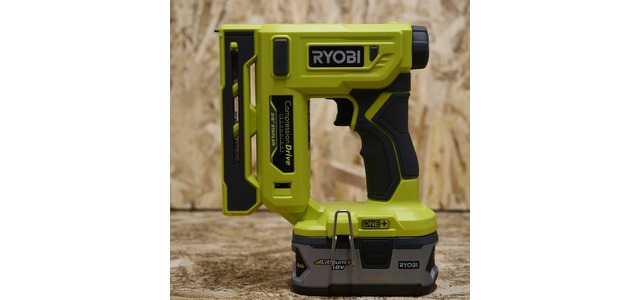
In February, we learned about the Ryobi P317 18V 3/8 Inch Crown Stapler which offers the ease of use and performance of an electric stapler with the portability only a battery powered tool can offer. In this review article we will check it out and go over it’s features and perfor
MANUFACTURER SPECS:
- Battery: 18V
- Type of Staples: 3/8 in.
- Magazine Capacity: 85
- Staple Length: 1/4 in. – 9/16 in.
- Staples per Charge: Over 5,500* (with 4.0ah battery)
- Tool Weight: 3 lbs.
- includes: P317 3/8 in. Stapler, 160 steel 1/2 in. staples, dual wire/screen attachment, belt clip, operator’s manual
FEATURES:
The Ryobi P317 18V stapler uses the very common Arrow T50 style staples found just about everywhere and the stapler has a variety of uses such as installing in wall insulation, upholstery, etc. Being a battery powered tool, everything needed to operate the tool is on board including the motor, compression chamber and battery pack that must be inserted in order to operate the tool and all you have to do is do a simple press of the trigger to install staples. This is much easier than squeezing a manual hand powered stapler and I find it that there is much less fatigue with prolonged use.
This particular cordless stapler uses similar technology from Ryobi’s previous cordless nailers in the sense that it uses a compression chamber to compress air which in turn is the driving force that fires staples. Although I’m not exactly sure how similar or different it is compared to their previous nail guns, what I can tell you is that it is called “Compression Drive Technology” on this new stapler while it’s called AirStrike Technology on their previous nailers.
It’s magazine is the same as the ones you’d find on better featured staplers as it’s very simple to use and install new staples. A simple press on the tabs at the back of the magazine allows you to open the magazine to insert new staples and they go in on on the underside while the unit is held upside down. Then once the staples are in place you can close the magazine and it locks into place. This is much better than the older magazines that required a bit more work and is not just easier, but faster too.
The magazine itself has viewing windows on both left and right sides of the unit to check your remaining staples and to see when you’re running low however only the left side of the magazine actually shows remaining staples. The right side while having a viewing window, does not show any staples when inserted. I’m not sure why this is but if you’re a left handed user, you wont be able to easily check the magazine window as you’ll have to turn the stapler to it’s left side facing you to check remaining staples. It’s not a big deal to me since I am a right handed user and naturally would check the left side of the stapler anyways but it might be a nuisance if you’re a lefty.
The magazine window also doesn’t go all the way up to the top meaning that once your remaining staples reaches a low amount of about 10-15 staples you won’t be able to know if you are completely out or still have a few but if you can’t see any at all it’s safe to say it’s time to reload.
On the top of the unit towards the back you’ll find a “Drive Force Indicator” window that allows you to check and set your desired amount of pressure for staple firing. This is change the depth of each staple driven whether you want them to lay flush, above flush or sub flush depending on your needs. To change the desired pressure, there’s a dial on the back that allows you to increase or decrease the driving force.
As a safety feature, this cordless stapler will not fire unless it makes contact with the surface. This is so you don’t accidentally fire any staples at yourself or others which would lead to injury.
While this stapler operates similarly to other cordless staplers, there are a few key features missing on this Ryobi stapler such as dry fire lockout and bump fire modes. The lack of dry fire lockout means that it will still attempt to fire staples even when the magazine is completely out. This means that the stapler will leave small indents on the work surface when it actuates while empty. In my opinion this isn’t a big deal because these kinds of staplers aren’t used on parts of the project that will be shown, so a few dimples as a result of misfires aren’t going to ruin the project. As far as the lack of bump fire mode goes, I would have preferred if it did have this feature but a regular manual hand stapler doesn’t have that feature or dry fire lockouts so in that sense you’re not missing much if you’re upgrading from the hand powered option. However I will mention that Milwaukee’s M12 Stapler which is very similar in design to this unit, (not a surprise since they’re both made by TTI), does offer proper nail gun feature such as dry fire lockout and bump fire mode along with a magazine viewing window that goes all the way up to the tip so you’ll be able to know you’re completely out of staples. At the time of writing, both the Ryobi 18V cordless stapler and the Milwaukee M12 stapler are the same price of $79 (M12 stapler used to be $99 baretool) which makes the M12 model a bit more appealing at the same price point. However if you’re in the Ryobi 18V system, it wouldn’t make much sense to jump on the Milwaukee M12 version of the stapler since you’d have to invest in another battery and charger platform and have to hassle with juggling two sets of incompatible batteries. I’d stay put in the Ryobi system if I was invested only in the Ryobi system.
The Ryobi 18V P317 stapler when compared to a traditional manual hand powered stapler, is heavier at 3 lbs baretool and when paired with the 4.0 ah battery I tested it with was a total of 4.5 lbs which makes it considerably heavier than the hand powered option. It’s also bulkier because the battery pack adds some bulk to the bottom of the unit. Some may complain saying Ryobi’s cordless version is too heavy or too bulky and they may have good reason to say so however I believe the added weight and bulk are a good compromise because it’s a lot easier to use than a hand powered stapler. You won’t get tired from the weight of a hand powered stapler when carrying it all day but you will get fatigued from squeezing and pumping it’s handle to pump out staples over and over. This is something I can’t say of the cordless battery option which is less tiring over long periods of use since a simple trigger press is all that’s needed to fire staples.
Ryobi also includes a clip on dual screen/wire attachment which “allows installation that guides staples without penetrating wire or screen”. I’m not exactly sure what this is for but I would assume it’s for installing something like the wire mesh needed for adding stucco to the exterior of a building. I have no comments or opinions about this attachment since it’s not something I’ve ever used or needed in the past but it might be useful for others. What I can say about it is that it is double sided and it clamps onto the front top of the stapler near the firing mechanism which is used to set the appropriate spacing for a specific application.
Other features include a belt clip that must be installed prior to use and can be placed on left or right hand side of the unit, ergonomic handle with textured rubber grip, no mar rubber bumpers on sides of the stapler and a brushed motor.
PERFORMANCE:
Long time Tool Craze follower Glenn has one of the older blue Ryobi 18V P300 staplers and was saying his unit was underpowered and required the assistance of a hammer to fully seat it’s staples. I’ve never tried that older model before so we’d have to take his word for it and it’s safe to say that the new P317 model is a very big improvement in the performance department. First of all it had no problem sinking staples into softwood lumber such as 2×4’s and was very consistent. In my testing, full power consistently sets staples subflush into the material, medium power sets staples consistently flush with a few subflush and a few above flush and the lowest power setting sets staples consistently barely above flush. Slightly above flush is perfect in most cases as it would not puncture the material being fastened such as the paper backing found on in wall insulation. When installing in wall insulation you wouldn’t want the staples to be flush or sub-flush since that would tear the paper and ruin the grip strength of the staple so personally I’d just set this stapler on it’s lowest power setting and forget it.
I’ve set several hundred staples with this new P317 stapler and not only does it consistently set them deep enough but none were improperly seated or required additional hammering to set correctly nor were there any that needed to be pulled out. So it’s a very consistent performer. As a disclosure, I haven’t set thousands of staples with it yet so I’m sure it’ll have the occasional improperly set staple at some point but so far it doesn’t look like that should be a concern any time soon.
I’ve used Ryobi’s Airstrike nailers many times in the past and currently own the 15 gauge nailer. They’re great nailers, with plenty of power and are very reliable. One thing that instantly stands out with the Airstrike models, is that they have a delay between trigger press and nail fire. This is because they have to compress air in a short amount of time to fire nails and staples. It’s not what I would call slow as they are still fast but there is a delay and It’s noticeable. That’s what’s interesting about this new P317 model with it’s newer compression drive tech because staple fires are instantaneous and fire just as fast as you can press the trigger. There’s no delay whatsoever and it performs more like a typical electric corded plug in stapler.
I mentioned that there wasn’t a bump fire mode on this stapler which can be found on the M12 Milwaukee version or other cordless nailers and staplers however considering the fact that this Ryobi P317 stapler lays down staples so fast and instantly that in my opinion, it doesn’t need a bump fire mode to be quick. Sure, I’d still prefer the actual bump fire mode to hold the trigger down and bump to fire over and over but I can still achieve multiple staple fires in a similar amount of time as I would with bump fire with repeated trigger presses. I would also go on and say it can be faster than a hammer tacker stapler since it’s faster to press a trigger and fire than it is to swing a hammer tacker over and over.
As far as runtime goes, according to Ryobi, you can expect over 5,500 staples driven with a P108 4.0 ah battery which is very impressive runtime for a cordless nailer. I didn’t test for runtime but I wouldn’t have any doubts that it can actually reach that number or close to it.
CONCLUSION:
While the Ryobi P317 18V stapler has a few quirks such as only being able to see remaining staples on one side of the magazine and the lack of standard nail gun features such as dry fire lockout and bump fire mode, I still feel they hit a home run with this stapler as it’s an excellent performer since it lays down staples instantly and without any delay, has the performance to consistently set staples to the desired depth, has excellent runtime and is very easy to use since it will not tire you out like a hand stapler would. It appears to be a big upgrade in the performance department compared to the previous blue series P300 stapler. The Milwaukee M12 Stapler might offer more bells and whistles for the same price point, I’d say that if you’re invested in the Ryobi 18V cordless system and need a battery powered stapler that uses Arrow T50 style staplers, look no further than the Ryobi P317 model.
PRO’S:
- solid performance drives staples to desired depth consistently
- instant firing, no delay like on Airstrike models
- excellent rated runtime of over 5,500 staples per charge with 4.0ah battery
- very simple and easy to use
CONS:
- no dry fire lockout
- no bump fire mode
- only left side of magazine window displays remaining staples
- remaining staples magazine window does not go all the way to the tip to show if completely out of staples
- heavier and bulkier than hand staplers although it is easier, faster and less tiring to use than hand stapler
Read the full review by Javier here